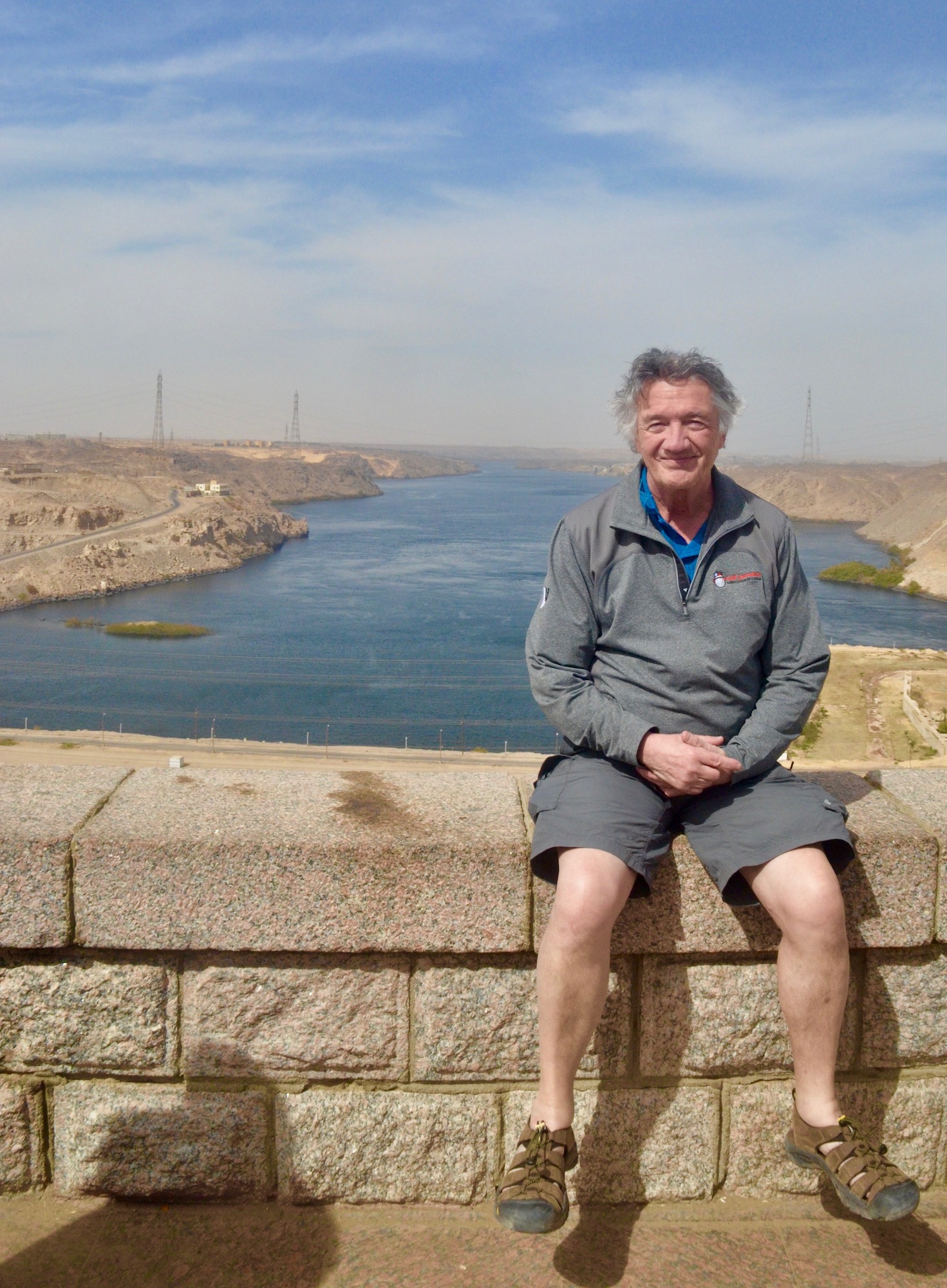Nubia – It Still Exists – Barely
This is the second of two posts on the many interesting things you can see and do in and around the small Egyptian city of Aswan. In the first post I discussed the best ways to get to Aswan, recommended a great hotel, provided links to my posts on Abu Simbel and the Philae Temples and toured the wonderful Nubian Museum. In this post we’ll continue exploring Aswan with Martin Charlton, our tour leader from Canadian tour provider Adventures Abroad and our great Egyptian guide Ahmed Hassem. Won’t you join us as we visit a village in ancient Nubia? But first some flowers and strong coffee.
Kitchener Island – Aswan Botanical Gardens
One of the great things about traveling around Aswan is that you get to spend a lot of time on the Nile River. Our first stop today is Kitchener Island which is home to the Aswan Botanical Garden. For ease of getting from place to place on the water it is easier to use the services of a motorized boatman than a felucca which is more for just cruising on the Nile and taking in the sights from the water. The boatmen decorate their boats with various themes, whether it be soccer clubs, famous people from Nubia or in the case of the guy Ahmed has lined up, Rastafarian.
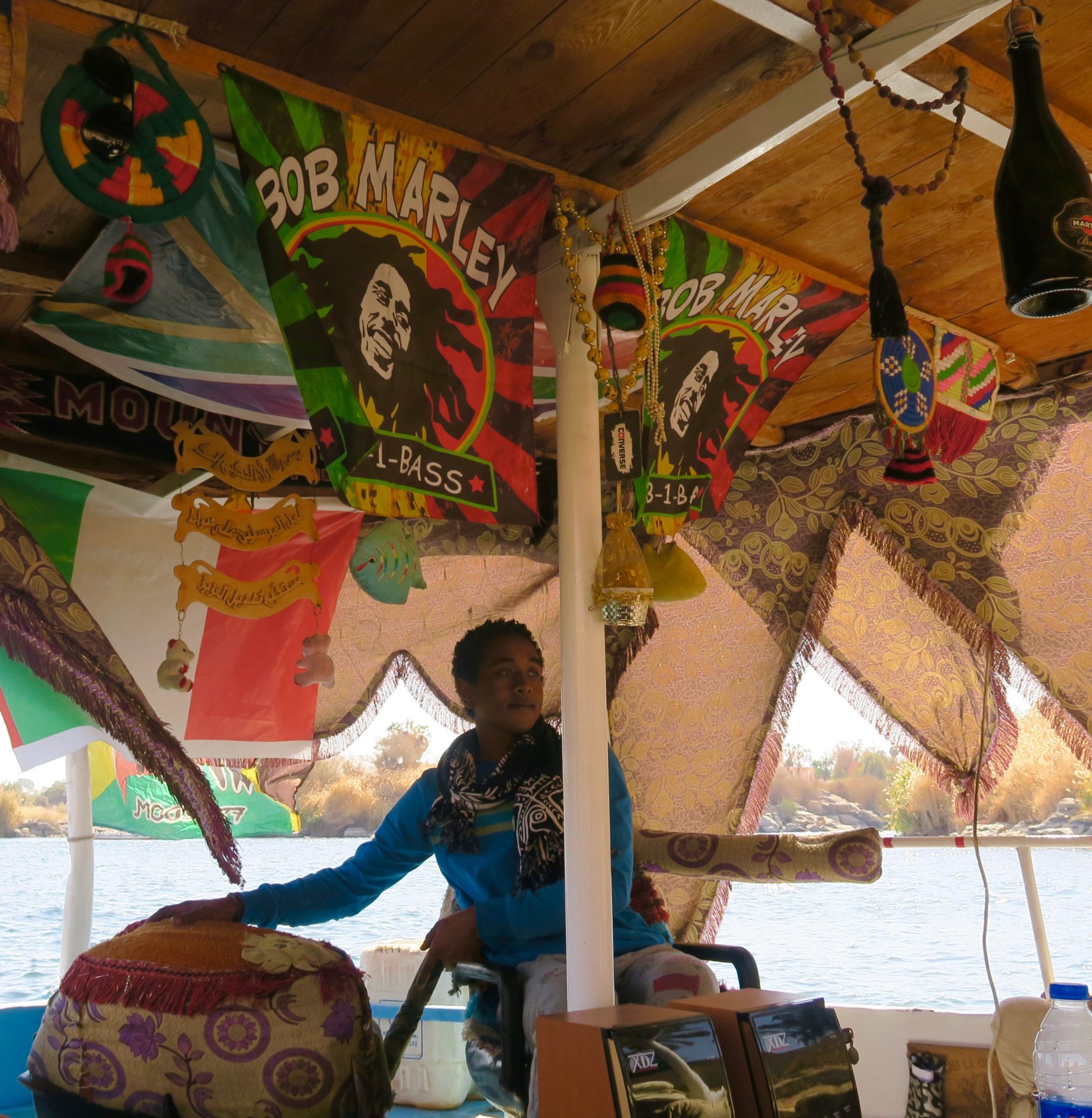
Through Ahmed, I get him to ask the boatman if he is a Rastafarian, which is more associated with Christianity, albeit in a strange way, than Islam. The answer, with a laugh, is “No, I just like Bob Marley.”
It’s a beautiful morning on the Nile and although a bit chilly by Egyptian standards, we still enjoy the sun. That’s Ahmed with one of our number and a crew member. Every boat seems to have a least one helper.
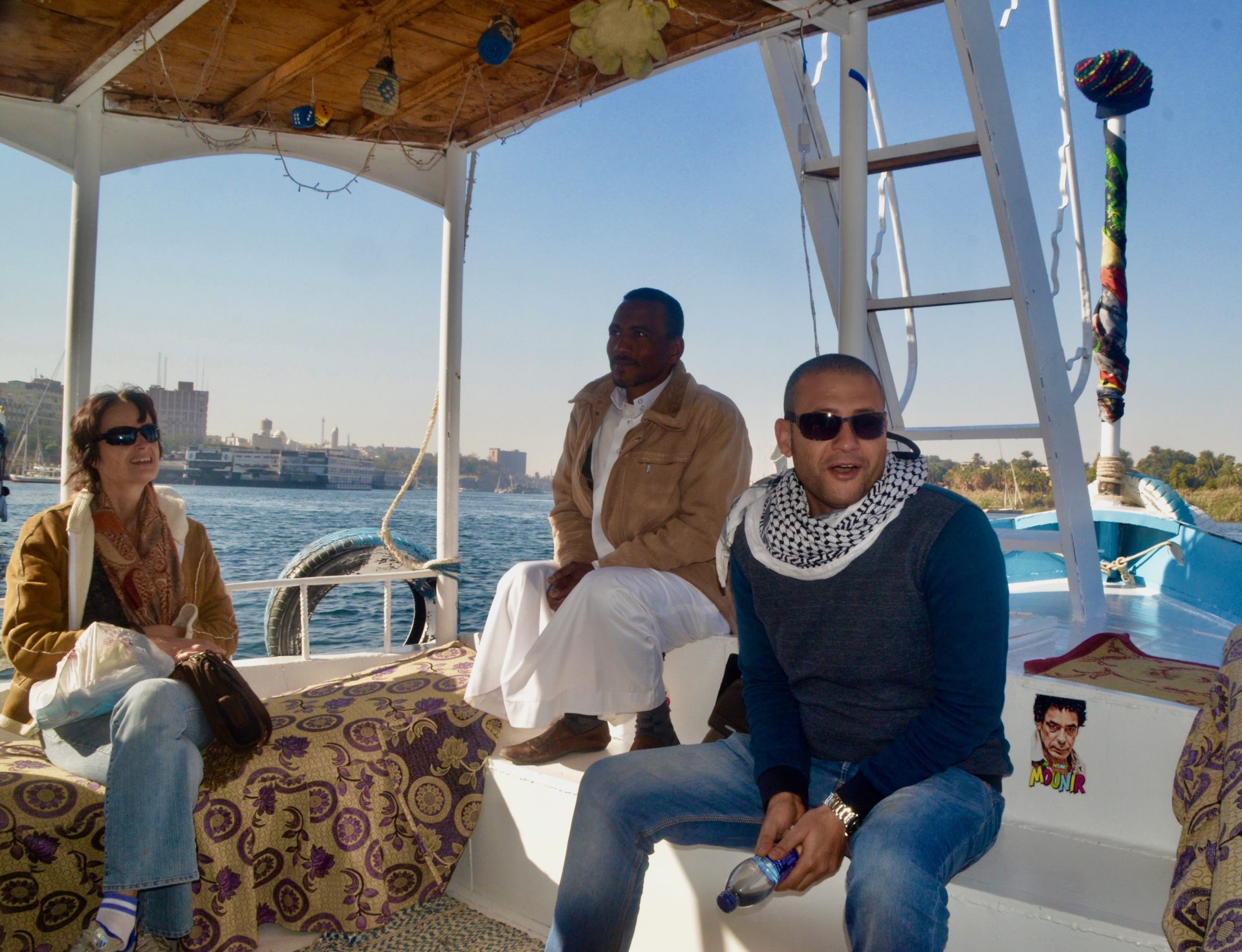
Along the way we get a very clear view of the Mausoleum of the Aga Khan high on an escarpment overlooking the river. It’s marble exterior fairly glows in the morning sunlight that bathes it from the east.
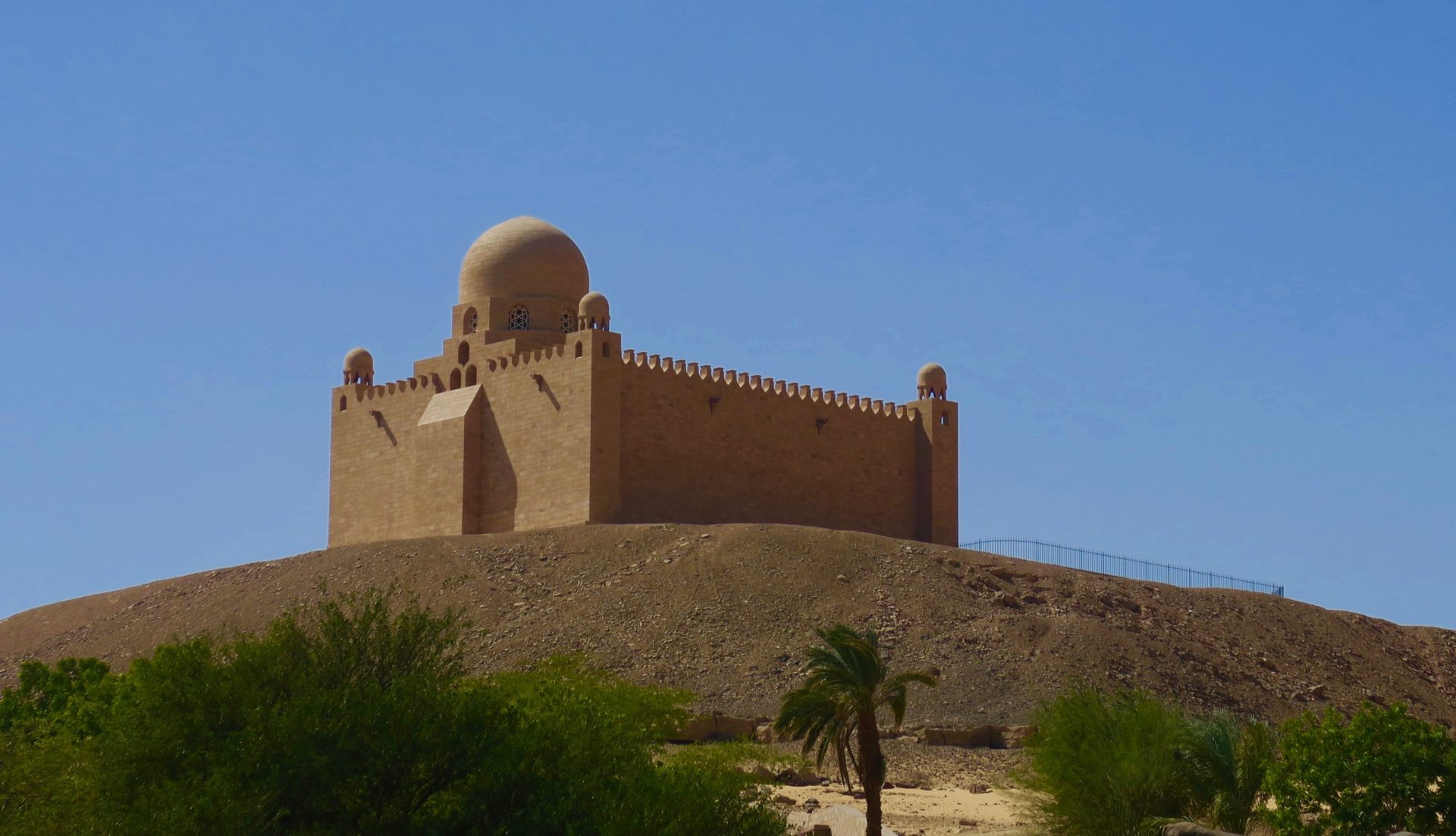
This is actually the tomb of Sultan Muhammed Shah or Aga Khan III, 1877-1957, a colossally important figure in late 19th and 20th century affairs of India, Pakistan and Shia Muslims worldwide. The Aga Khan is the spiritual head of the Ismaili sect of Shia Islam. This particular Aga Khan was western educated, as is his successor, and was always a voice of moderation that brought him great respect not only among Muslims, but among all nations. At one time he was even the head of the League of Nations. The reason the Aga Khan’s tomb is in Aswan and not his native Pakistan is that he loved this area and had one of his homes not far from the site of the mausoleum. It is not open to the public, but still a very interesting sight from the Nile.
There are places you can visit on the western side of the Nile at Aswan, which has its own mini version of the Valley of the Kings with tombs ranging from the Old Kingdom to the Roman era. In fact, they are still discovering new tombs as recently as this month (June 2017) as evidenced by this article. From our boat we could see parties ascending the paths up to the tombs which, like the Valley of the Kings, are cut into the rock faces of the cliff. The building on top is another Shia mausoleum dating from a much earlier time than the Aga Khan’s.
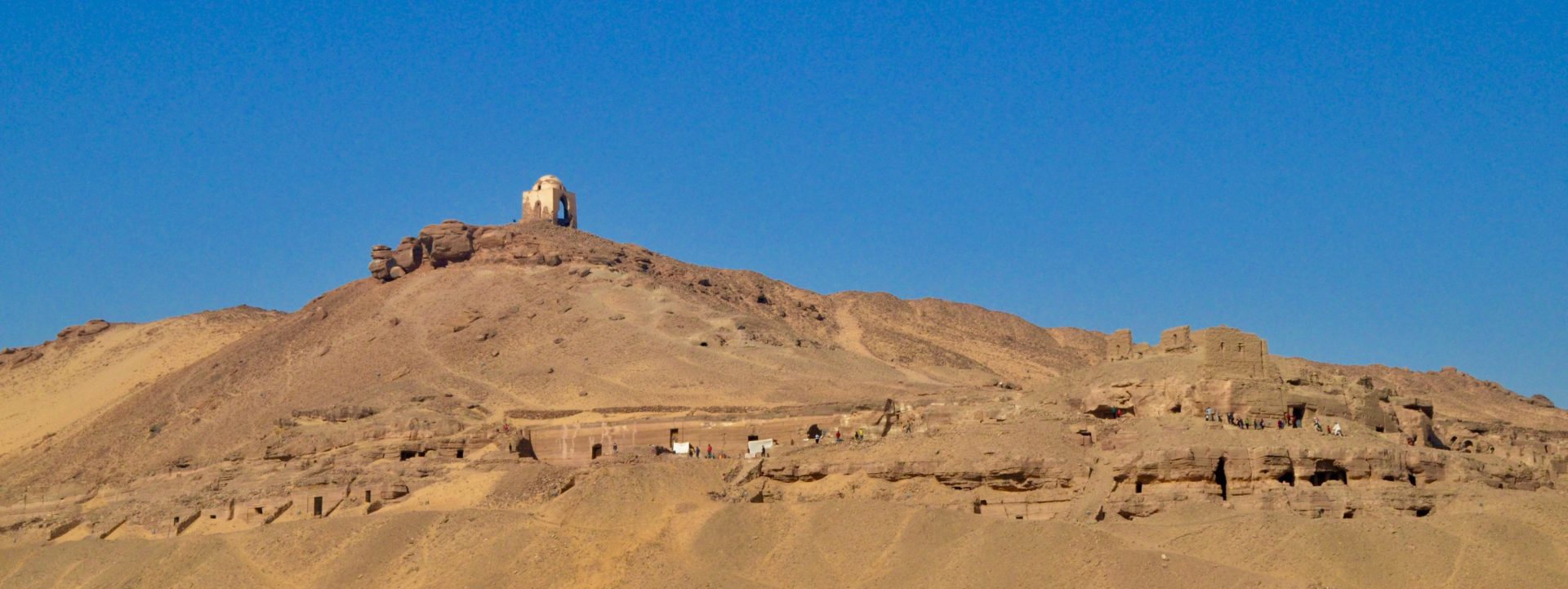
The boat docks at Kitchener Island which was once the sole property of the great British military man, Lord Kitchener who was proconsul of Egypt and Sudan from 1911 until the outbreak of WWI, when he was convinced to become the Secretary of State for War. He decided to turn what would have been a dry and arid place into a botanical garden that has become an oasis of green that is a favourite destinations for locals and tourists alike.
This is Alison at the entrance to the Aswan Botanical Gardens.
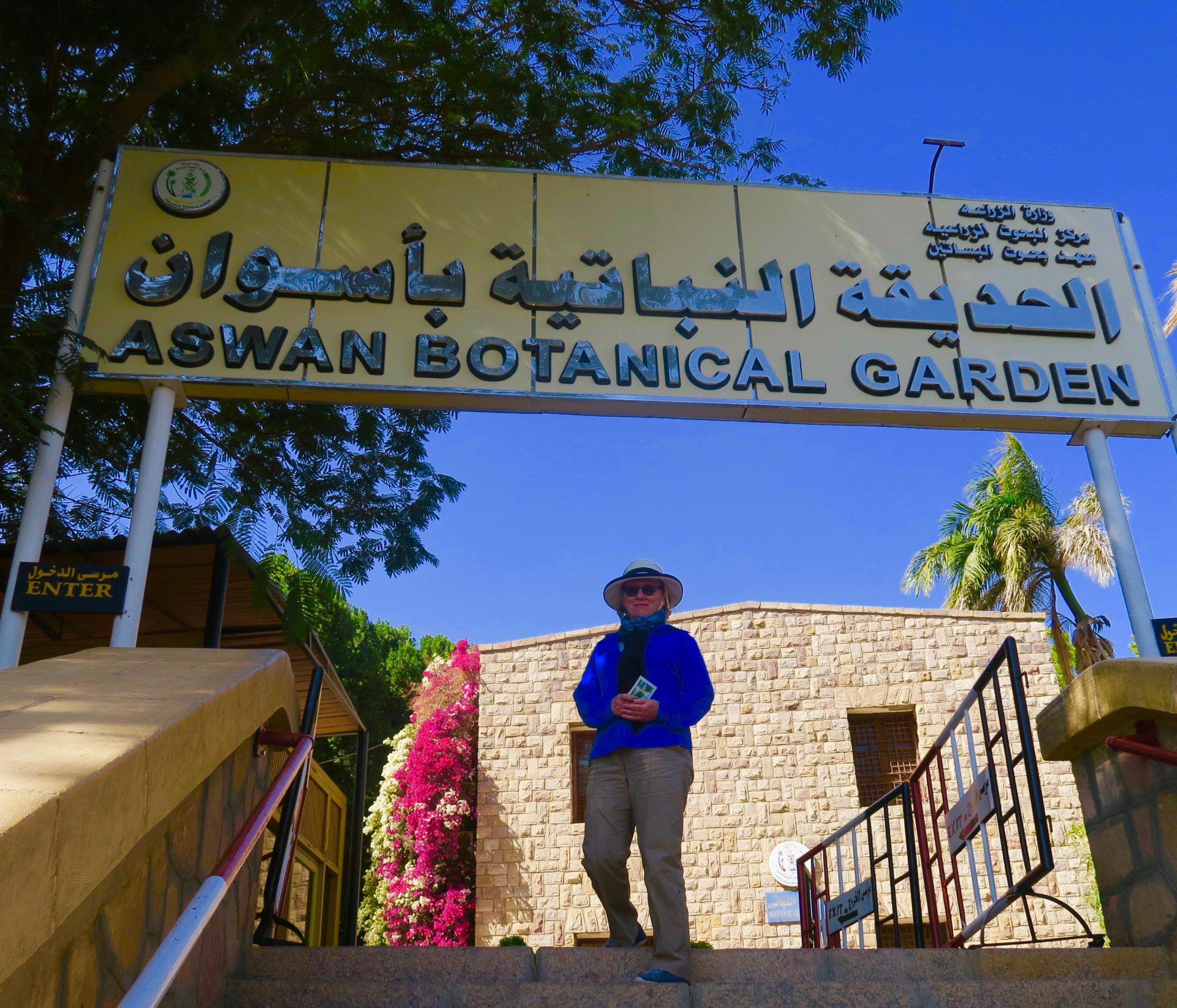
As botanical gardens go, Aswan is not going to make anybody’s world top ten list, but it is a place of tranquility and in a country that jams 90 million people into a sliver of land along one river, a place to get away from the crowds. There was no question that this was a popular spot for both families and young lovers, albeit you would never see the open displays of affection (sometimes too open) that you might see in a western park. After strolling around both sides of the island we rejoined the group at a small outdoor cafe where I had an excellent Turkish coffee in this lovely Egyptian motifed demi-tasse. If I wasn’t fully awake before I drank it, I sure was after.
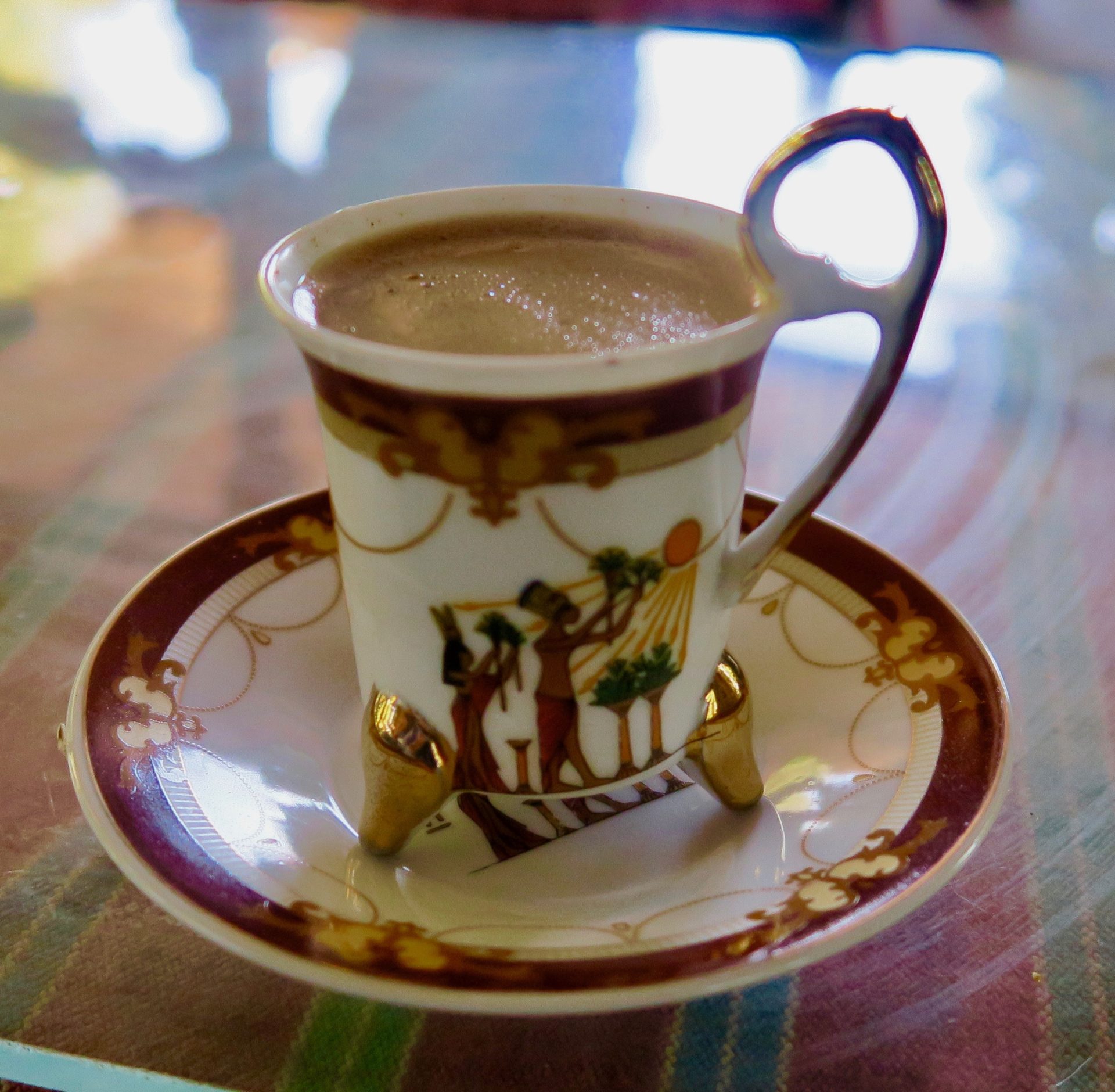
Nubia Still Exists
After reboarding our Bob Marley boat, we headed upstream passing numerous islands on our way until we made our way onto a fairly crowded landing quay on the west side of the Nile. Our destination was a village in what was once the Kingdom of Nubia where we would purportedly get to meet ‘real’ Nubians going about their daily business. I am always leery of these type of cultural encounters. Is it a legitimate experience or one just cooked up for tourists? Are we exploiting these people or maybe, are they exploiting us, by putting on what really is just a show? The saving grace was that I knew from previous experience that Adventures Abroad doesn’t go in for this type of thing and that turned out to be the case.
Nubia was the kingdom that lay to the south of Egypt and although the boundaries moved back and forth over the millennia, it was generally considered that first cataract of the Nile which is very close to Aswan, marked where Egypt ended and Nubia began. From there the kingdom covered an area all the way up the Nile to modern Khartoum in Sudan. The two kingdoms were great trading partners with raw materials like gold, ivory and lumber going north from Nubia to be exchanged for cloth, beer and other manufactured products. Occasionally the two kingdoms would go to war with Egypt conquering portions of Nubia and vice versa.
Until this trip I had assumed that Nubia had simply disappeared into the wisps of history, so I was surprised to learn that Nubians still exist as a distinct group within Egypt today, with their own language, customs and architectural building style. Unfortunately for them, most of their traditional lands were lost with the creation of Lake Nasser, their villages along the Nile inundated by the rising waters. Many were forcibly relocated, their lands confiscated without compensation. Fifty years on, the issue of compensation in land and/or money remains a hot topic in Egypt with the prospects for the Nubians getting something at long last seemingly better than ever.
A Village in Nubia
On the way to the village proper we passed a number of structures which Ahmed explained are typical examples of Nubian homes. They reminded me of the tiny Greek Orthodox churches you’ll find in the most remote places of Greece and occasionally Turkey. Built to withstand the unremitting heat of the Sahara, they have remained largely unchanged in design for thousands of years. Note that there is no electricity or water. One of the legitimate complaints of the Nubians displaced by the creation of Lake Nasser was the failure, even after almost fifty years, to provide them with the most basic services which most Egyptians take for granted. That being said, most of the homes in the village proper did have electricity and water.
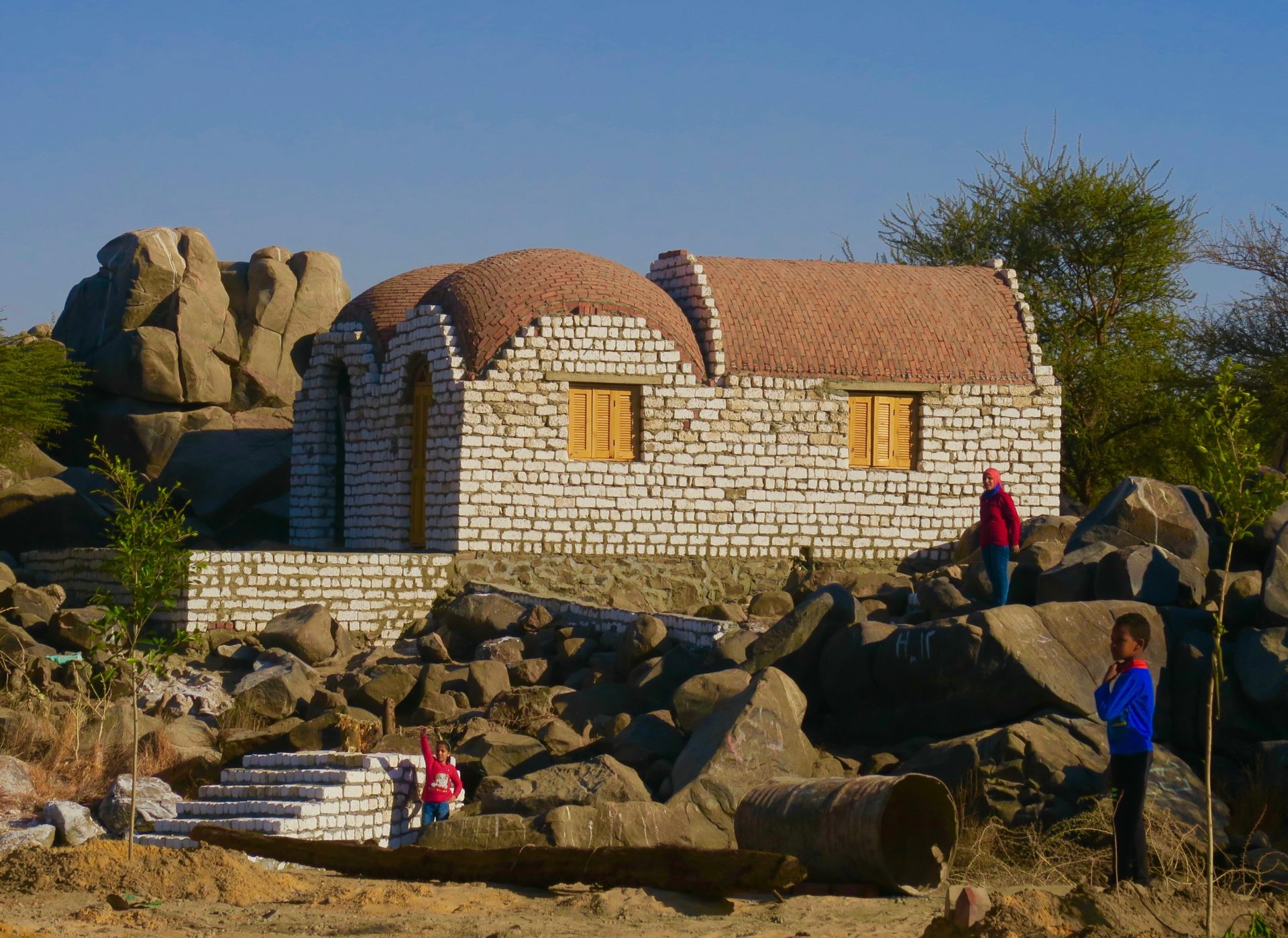
Our first stop was not in the ‘typical Nubian home’ I was expecting, but rather at the tiny schoolhouse where we had a chance to meet the village teacher, Omar. We were given a lesson in the Nubian alphabet by Omar, who made it clear that failure to pay attention would be addressed by way of martial punishment. That’s Ahmed doubling as the slow learner.
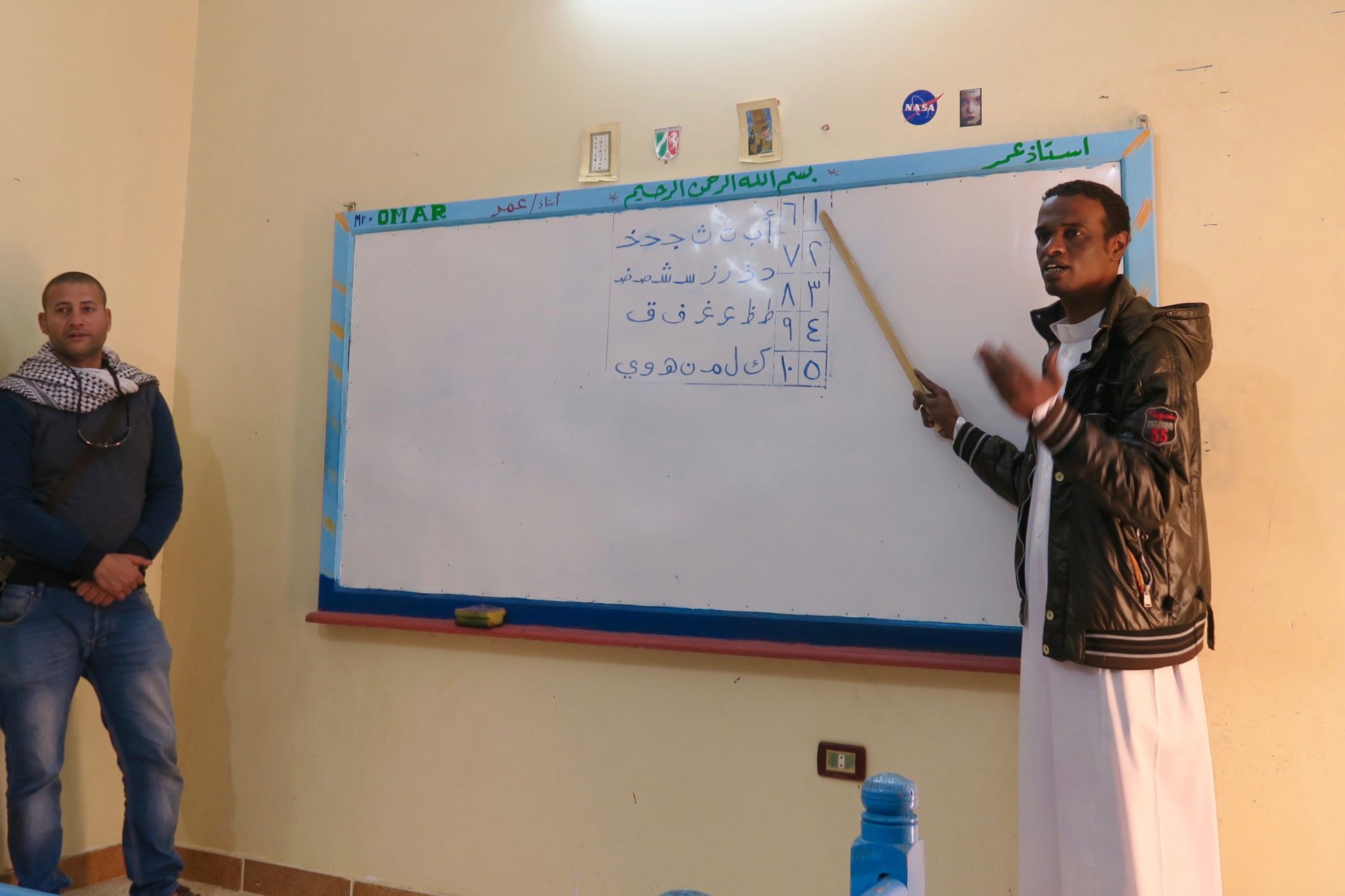
I always have my doubts about giving to charities that purport to help educate children in third world countries, but everyone in the group was happy to make a contribution for school supplies in this impoverished community in Nubia.
Having traveled on many continents and in dozens of countries of various degrees of prosperity I have found that they all have one thing universally in common – kids and dogs. By that I mean that no matter what their situation, children and dogs are almost always happy, especially when together; blissfully unaware that life is not eternal and that things are probably only going to get worse when they become aware of that fact. Luckily for the dogs, they never do. This place was no different.

The interior of the home in Nubia we were invited into surprised me. There was clearly some kind of extended family meeting going on in the large common room, but they largely ignored us as we poked our way into their daily lives. This was the kitchen where tea was being prepared for family and guests.
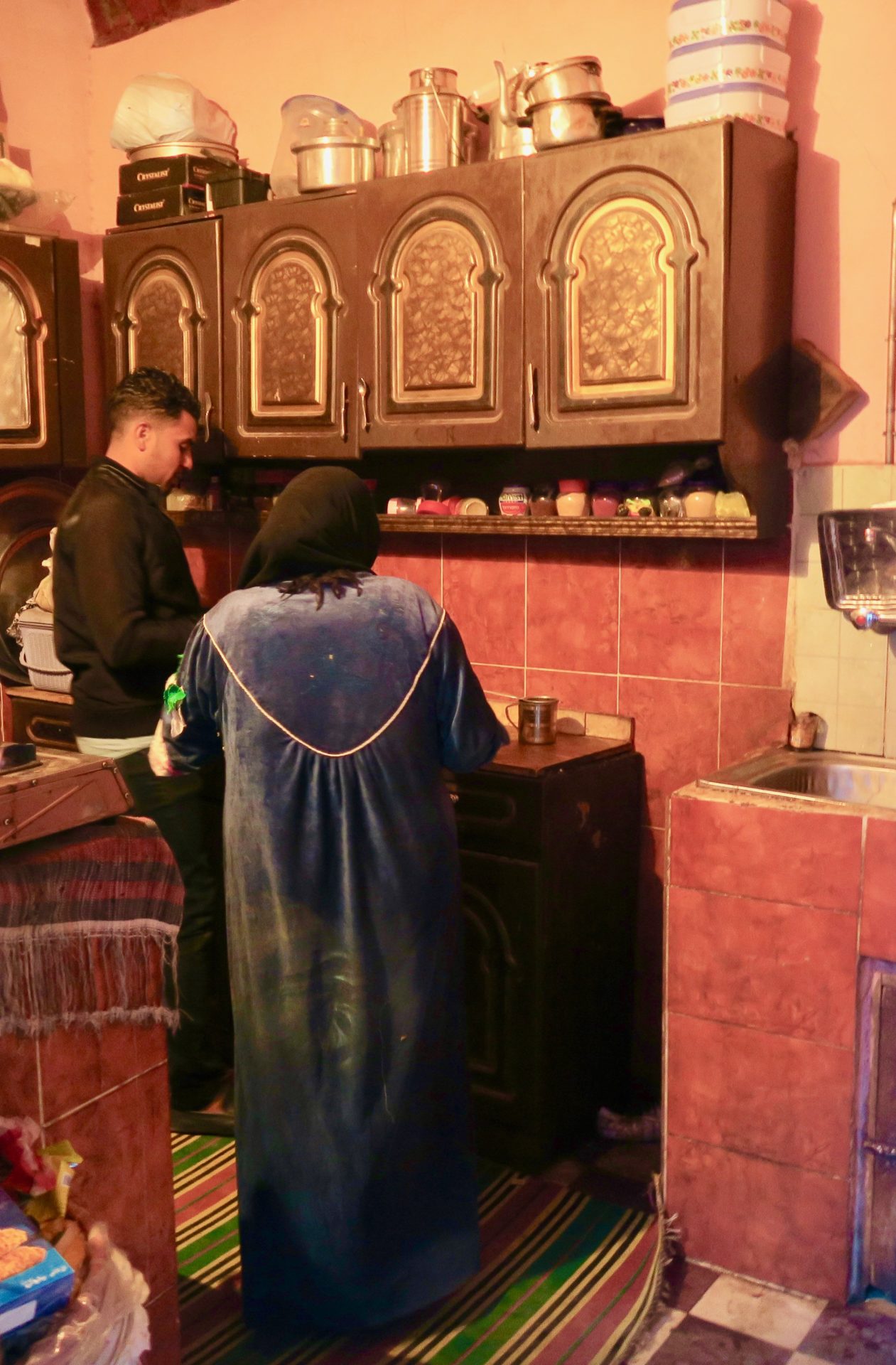
Back on the streets of the village we made our way back to the boat passing this spice and craft shop along the way, which took the meaning of ‘local colour’ to a whole new level. As we
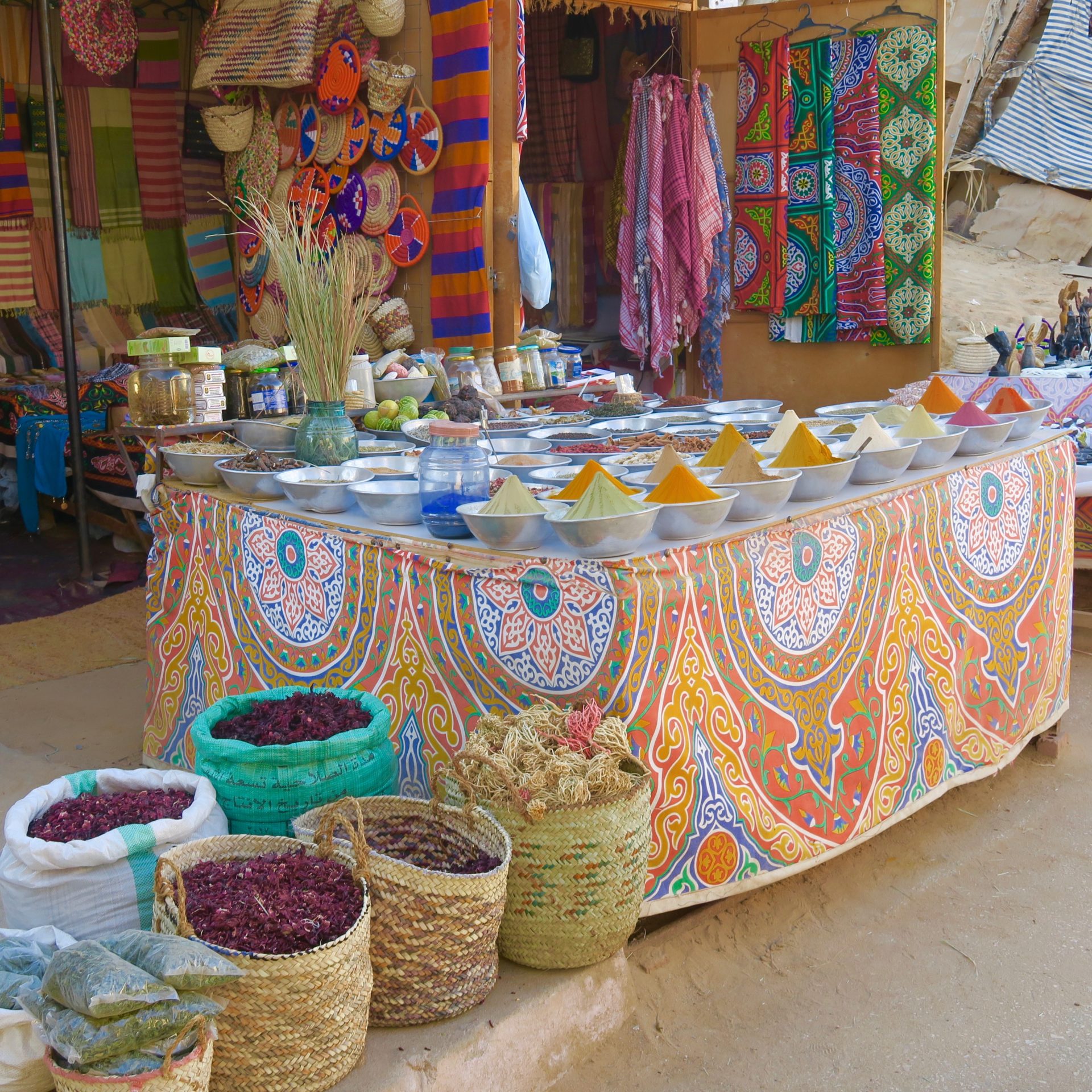
The Unfinished Obelisk
In ancient times Aswan was known not only as the last stop on the way to Nubia, but also as home of great granite quarries where the famed obelisks of Egypt were created before being barged up the Nile to Luxor and beyond. The obelisk is second only to the pyramid as a shape or form unmistakably associated with Egypt. Predating the first pyramid by centuries, the obelisk represented the beginning of all life. It is such an enduring symbol that the obelisks erected throughout Egypt became the objects of thievery as long ago as the Roman Empire. Anyone who has been to Rome, Paris, London, Istanbul or even New York will be familiar with Egyptian obelisks that have been raised in those cities after being removed from their ancestral homes in Egypt. Before departing on this trip I made a point of visiting the amazing Egypt gallery of the Metropolitan Museum in New York and then going out back to take this picture of ‘Cleopatra’s Needle’ in Central Park. Of course it predates Cleopatra’s reign by at least a thousand years, but what’s in a name?
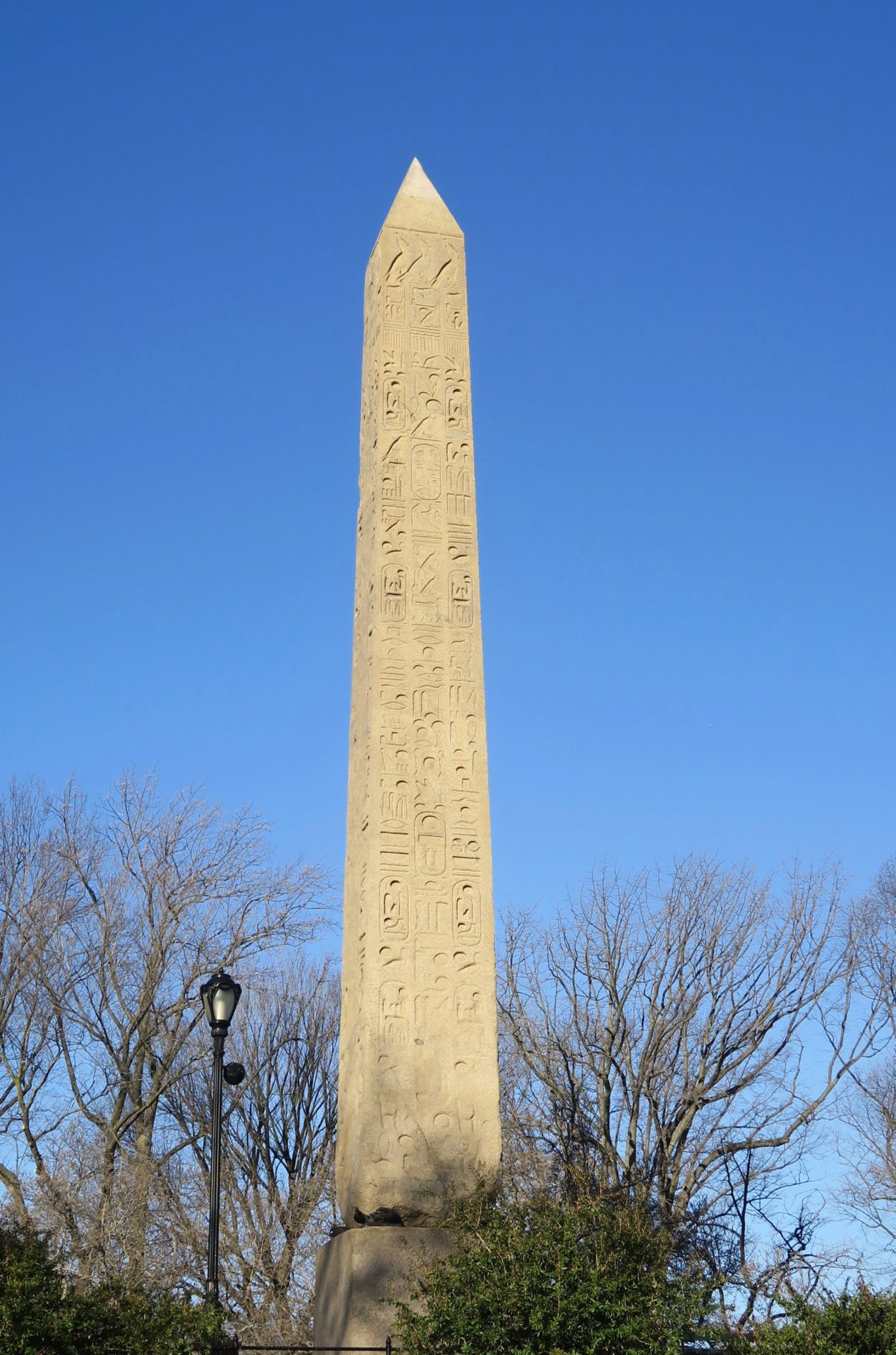
The largest obelisk to ever be sculpted/constructed/quarried (nobody is entirely sure how they were made) sits unraised in a quarry right in the middle of Aswan. It was commissioned by Hatshepsut for the temple in Karnak, but cracked when it was almost finished. I can’t imagine the hair pulling that would have occurred after the incredible amount of time and effort to get the thing as far as advanced as it was and then …, just crack. Anyway, the sands of time have not covered it over and it remains one of the most popular tourist attractions in Aswan today. Have a look.
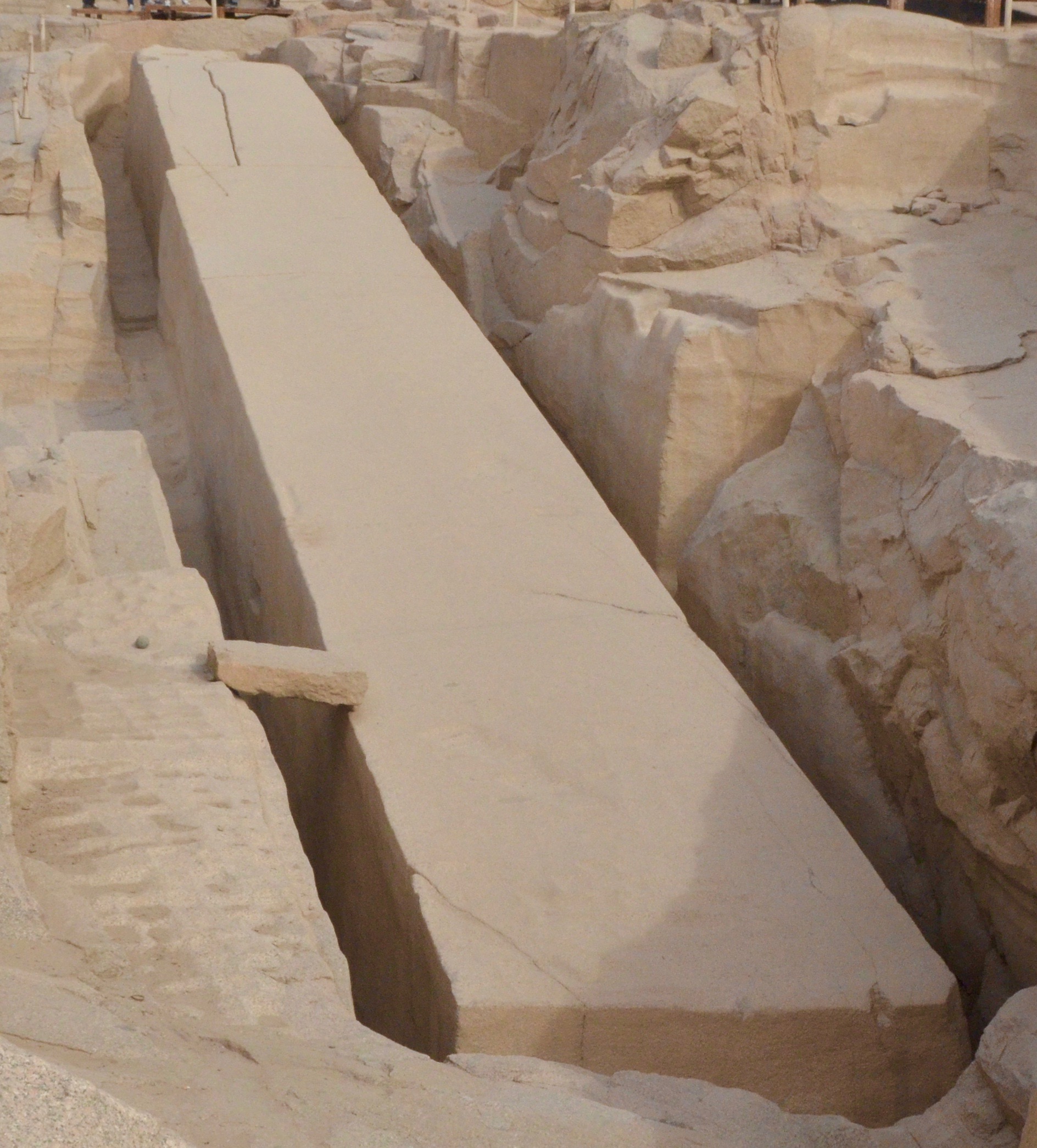
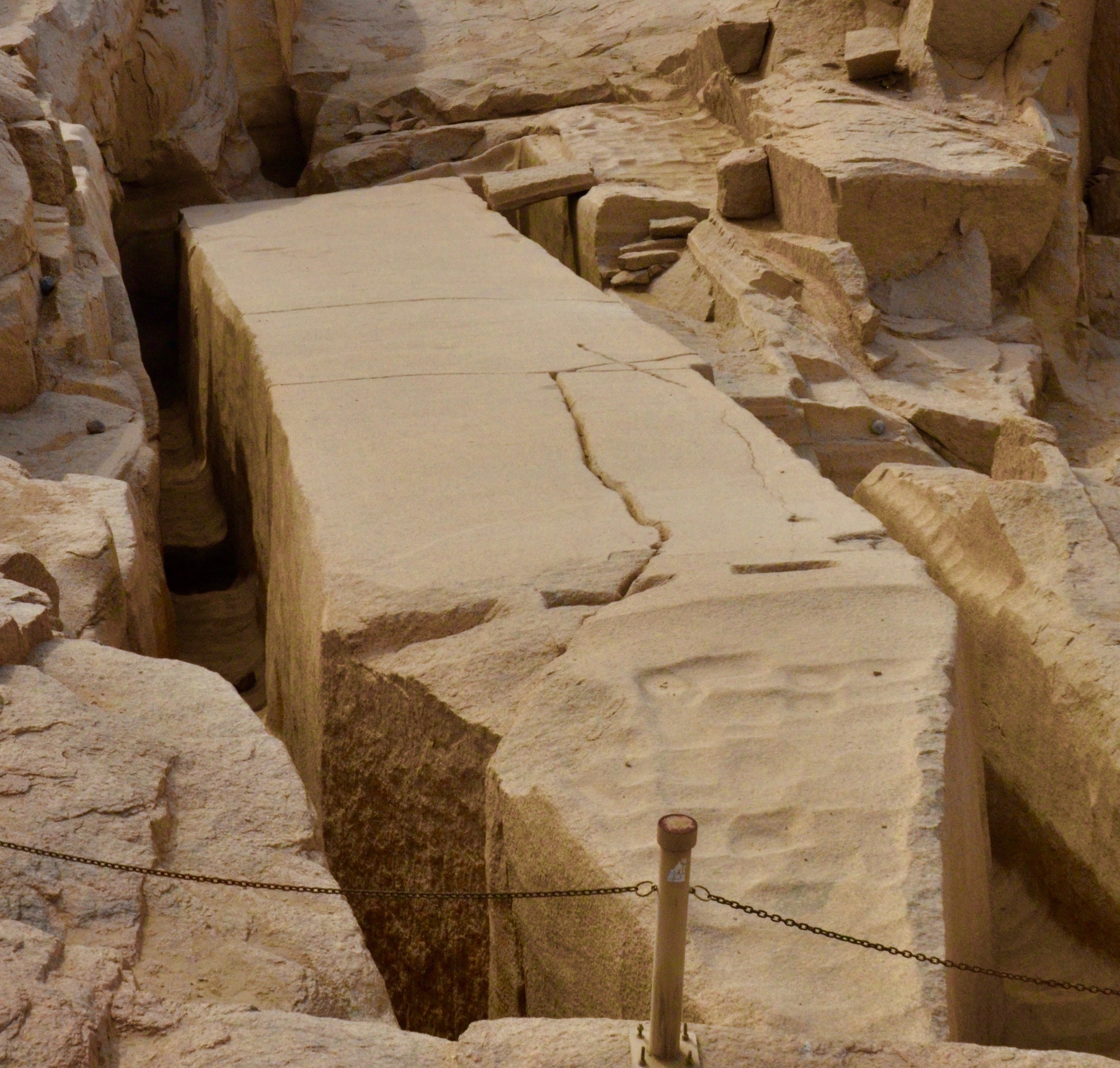
A visit to the quarry isn’t limited to seeing one of the most colossal failures in the ancient world, but also to see the many spots where obelisks were successfully created and removed. It’s kind of too bad that the place is more noted for it’s one big flop, than its many successes.
The obelisk remains a captivating symbol right up to modern times, none more famous than the Washington Monument, but it was really quite something to stand on the very spot where this mania started, perhaps as long as 5,000 years ago.
The Aswan High Dam
Of all the sites associated with modern day Aswan, without doubt the one most known around the world is the High Dam, built by the Russians and finished in 1970. In contrast to the usual saying, I have saved the least for last. Of all the places we visited in Aswan I found the High Dam the least inspiring and not because of the controversies surrounding it’s creation or because I’m one of those who oppose building dams on principle. After all, I’m a Canadian and one of our national symbols is the beaver so how could I not like dams? In their way, some dams, like Hoover, are wonders of engineering and architecture that rise to the the status of national icons. But not, at least for me, the Aswan High Dam. To me it came across more as the Lada of dams and not just because both were built by Russians. Here is an aerial view.
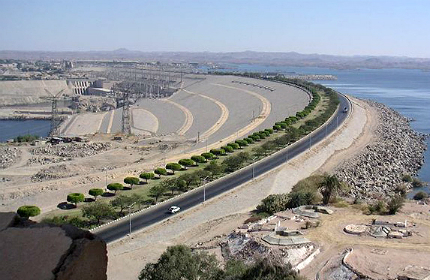
What they did was simply pile up millions of tons of rock and put a concrete cap on it. There is no sense of height that you get looking over the steep side at Hoover or many of the European dams like Almendra in Spain. Still, it is interesting for its views from both sides.
I have not adjusted the colour in this photo. The Nile really is that blue just below the dam. All of the sediment that would have made it a cloudy brown is now piling up in Lake Nasser.
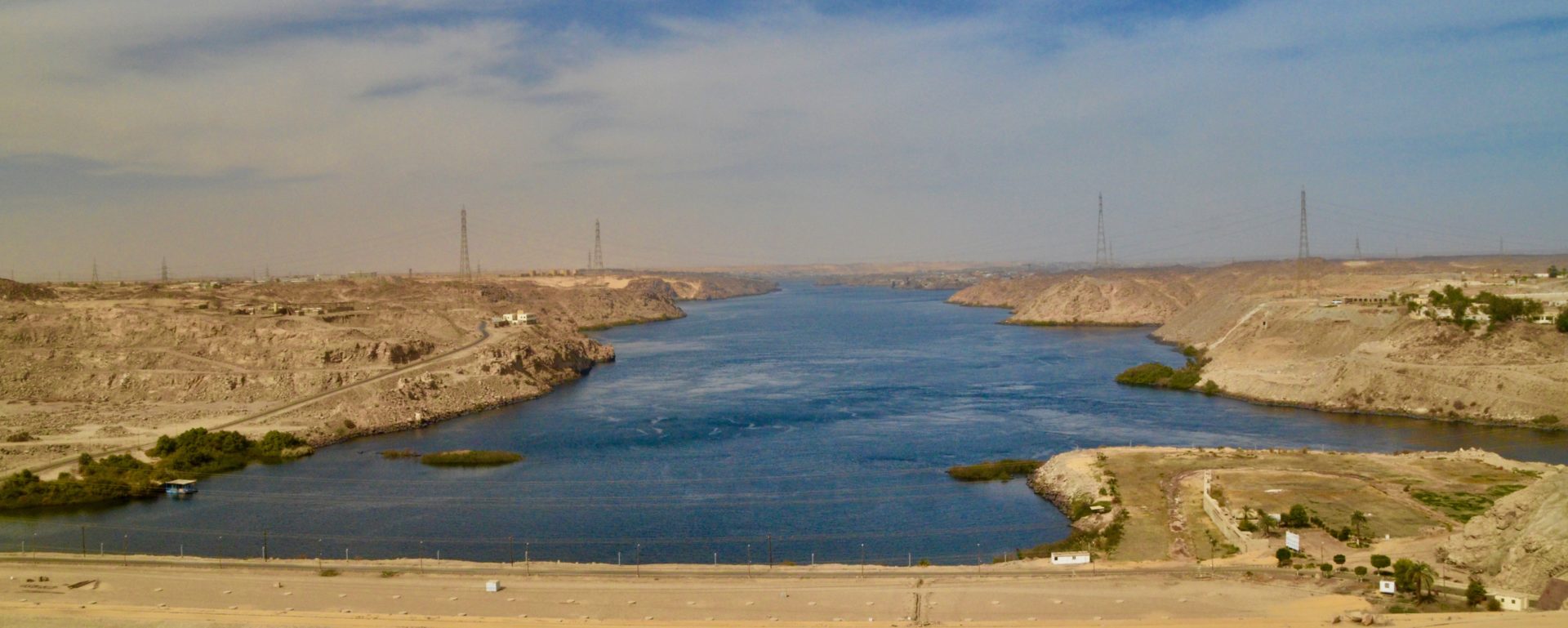
I almost forgot to mention something that you can hardly miss on a visit to the High Dam. This is the Monument to Friendship constructed in the Brutalist architectural style the Russians loved during the 1950’s and 60’s. And yes, it is brutal.
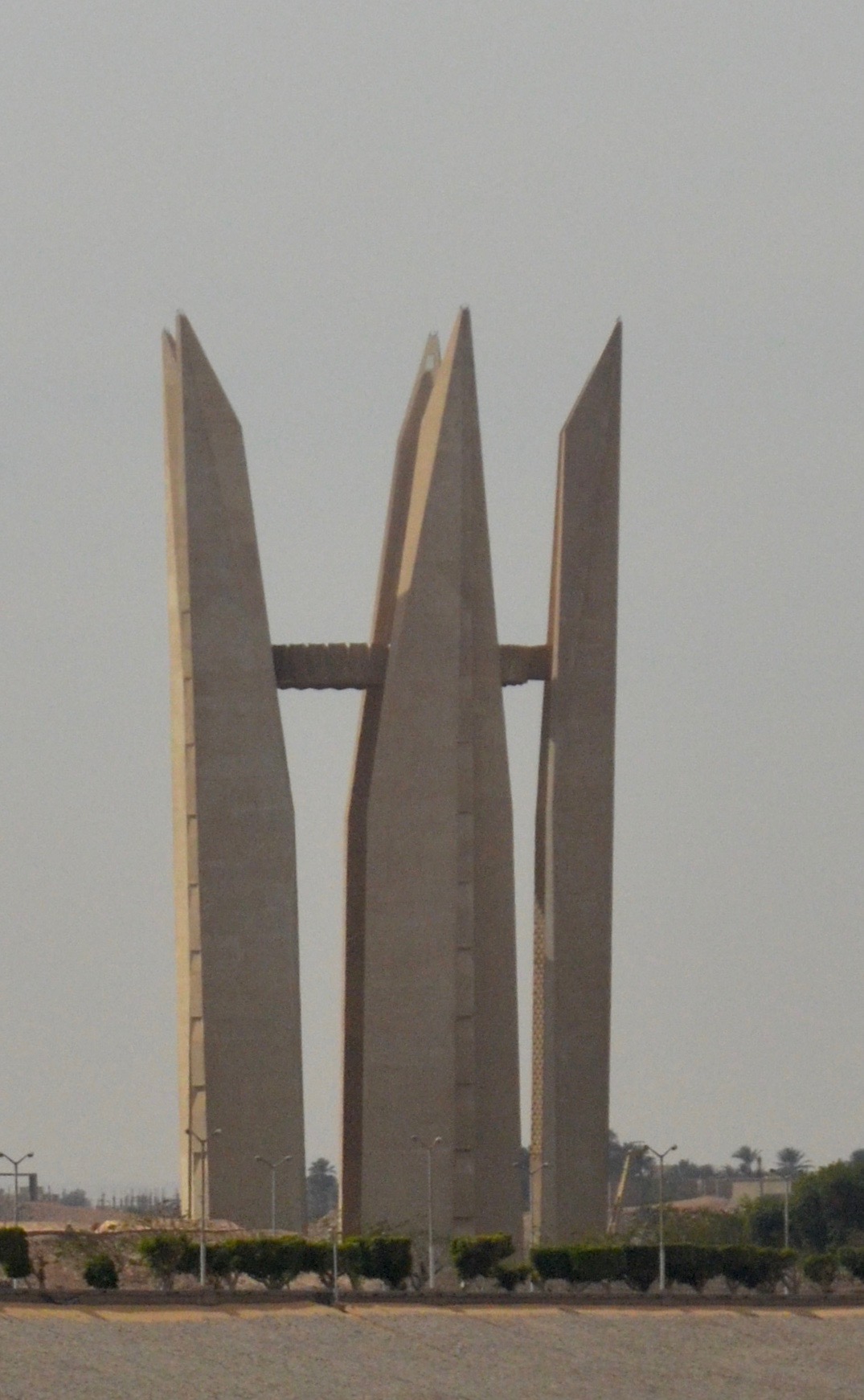
So that’s my take on the many reasons for including Aswan on your must-visit list of places in Egypt and surprisingly, Nubia. Next I’m off on a Nile cruise from Aswan up to Luxor. Hope you’ll come along for the ride. In the meantime, here is a link to the Egypt photo gallery with pics from every post.
Ila-liqaa from Aswan.
